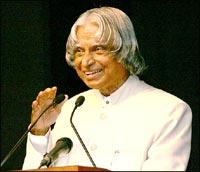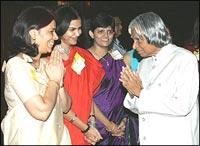|
|
| Help | |
| You are here: Rediff Home » India » News » Columnists » APJ Abdul Kalam, President of India |
|
| |||||||||||||||||||||||
|
| |||||||||||||||||||||||
'Media for a billion people.'
That was the topic of President APJ Abdul Kalam's [Images] speech at the 11th anniversary celebrations of the Indian Women's Press Corps (IWPC) in New Delhi [Images], October 9.
Here we reproduce the President's speech on the occasion:
 In a billion people of our country, seven hundred million people living in six hundred thousand villages, the events and news have to be unique and large when compared to other countries. Hence our print media has got a great challenge. Our news reporting is mainly urban based in many of our States. This situation needs change. I consider the newspapers or media are indeed a partner in our national development. A partner means "somewhere an innovative use of organic cultivation is taking place and the productivity of wheat or rice is increased by two times", this indeed is a very important news.
In a billion people of our country, seven hundred million people living in six hundred thousand villages, the events and news have to be unique and large when compared to other countries. Hence our print media has got a great challenge. Our news reporting is mainly urban based in many of our States. This situation needs change. I consider the newspapers or media are indeed a partner in our national development. A partner means "somewhere an innovative use of organic cultivation is taking place and the productivity of wheat or rice is increased by two times", this indeed is a very important news.
This news must be studied, analyzed and propagated to many places in the country. Similarly, a water pond which for years remained unused and the farmers have collectively worked together and make it operational, this is indeed a big news and must be reported. Such reporting will enable desilting and rejuvenation of lakhs of water bodies which are non-operational today in many of the states. Similarly, a constructive criticism of how the panchayat is working, how the flow of funds from the government is reaching the required development project must also be reported so that necessary corrective measures can emanate. I would like to discuss the importance of media research.
Media Research
I have a suggestion particularly to the members of Indian Women's Press Corps consisting of editors, journalists, correspondents and reporters. In our country it is essential to have research wings in the academic institutions and media establishments in developing quality and proactive media personnel in reporting news, event analysis, and multi-media design. The owners of newspapers and electronic media should encourage research being carried out by experienced and young reporters for acquiring post-graduate qualifications which will improve the quality of content of the print and electronic media.
For example, before any issue is discussed in foreign newspapers and electronic media, they send it to an internal research group where data is studied; verified and factual news is generated and sent for publication and broadcasting. When there was a critical comment about outsourcing to India, a US journalist stayed in India and studied the issue and found out that the companies engaged in Business Process Outsourcing were carrying out business using imported equipments from the UK and USA. Thus, they found that the BPO industries provided an indirect market for the hardware industries of the US. Immediately this was reported in the Indian media in a big way. Similarly a Discovery Channel media-person wanted to study India's growth in Information Technology; Thomas Friedman came to India and stayed for a month and visited Bangalore and other places. Based on his news analysis he wrote a book titled The World is Flat. This book has become famous not only in India but throughout the world. Such is the power of research.
I would suggest our Indian newspaper agencies and electronic media should encourage research being carried out by our correspondents and journalists within India in an academic research institution or media establishments which will definitely improve the quality of our reporting and analysis.
Emerging women
While talking to you, I am reminded of Mahakavi Subramaniya Bharatiar, who in 1910 composed the poem envisioning women of India:
 This beautiful poem means -
This beautiful poem means -
She walks with raised head, with her eyes looking straight,
She has her principles, unafraid of anybody!
She has a lofty and knowledge based pride,
Women of excellence, don't falter from the chosen path.
She drives ignorance away. She welcomes the bliss of life.
With learned mind, this is the Dharma of emerging woman.
The dream of the poet for emerging women aptly suits the women journalists in the country. The poem highlights the power of the knowledge of women. Now, I would like to discuss the role of women in nation building
Women in Nation Building
In our country, women constitute 48% of the total population. Recently, when I was in Himachal Pradesh [Images], Vijaya Sharma of Rajkiya Kanya Mahavidyalya asked me what should be the girls' role in independent India. I told her that there is really no difference in the roles. They are equal partners in national development.
Now-a-days women are shining in every field. They are becoming doctors, engineers, advocates, teachers, political leaders, administrators, police officials, professionals, businesspersons, media-persons and they also have joined the Armed Forces. You have all got to get ready to take the responsibility of promoting a noble society.
I would like to share some of my experiences, where I have found women performing pioneering work in their area of specialization.
I was inaugurating the '2nd National Conference for Women in Police 2005' on July 27, 2005, at Uttaranchal. There I met Smt Kanchan Choudhry Bhattacharya, the first woman to become the director general of police of Uttaranchal. I have seen many of the captains of commercial aircraft who are women. In the healthcare and education sector women are leading. In the political field also many women are playing a leading role.
 At Delhi, I met two very senior Air Force and Naval Officers, Air Marshal (Mrs) P Bandopadhyay, director general, Medical Services (Air) and Surg Vice Admiral (Mrs) Punita Arora, director general, Medical Services (Navy). They are doing pioneering work in the medical field. On June 27, 2005, the Chief of Army Staff brought the first women summiteers Capt (Ms) Sipra Majumdar and Capt (Ms) Ashwini AS Pawar, who climbed Mt Everest from the North side, that is from the Tibetan side.
At Delhi, I met two very senior Air Force and Naval Officers, Air Marshal (Mrs) P Bandopadhyay, director general, Medical Services (Air) and Surg Vice Admiral (Mrs) Punita Arora, director general, Medical Services (Navy). They are doing pioneering work in the medical field. On June 27, 2005, the Chief of Army Staff brought the first women summiteers Capt (Ms) Sipra Majumdar and Capt (Ms) Ashwini AS Pawar, who climbed Mt Everest from the North side, that is from the Tibetan side.
I also talked to the women army officers in the freezing temperature at Kargil [Images], when I met them at Kargil. I appreciate their courage and perseverance for succeeding in their missions. During 1980s to '90s there was colleague of mine in DRDO, Rohini Devi, scientist in the area of composites. She was responsible for developing the heat shield system for Agni missiles.
Dr Shanta who was recently conferred Raman Magsaysay award, I am familiar with her work in cancer research. She was responsible for setting up the Radiation Oncology Department in Cancer Institute and organized the first-ever hospital tumour registry in India. She also established the first pediatric oncology unit. Above all, Nobel Laureate Mother Teresa represents the embodiment of removing the pain of the suffering.
These women who have performed pioneering work in their own area of specialization should become role models for all of you. Similarly, in journalism, many of you are well-known for your pioneering work, reporting and columns.
Particularly, enlightened women are very important for nation building since their thoughts, way of working and value system will lead to faster development of a good family, good society and a good nation. Thus, women in all walks of life have a tremendous opportunity for participating in the development of the nation. One of the programmes in which they can make significant contribution is PURA.
Women Engineering College and Rural Development
I had visited the Periyar Maniammai College of Technology for Women, Vallam in Thanjavur district of Tamil Nadu and inaugurated a PURA Complex. I thought of sharing with you the developmental concept of a cluster of over 65 villages near Vallam, which involves a population of 3 lakhs.
This PURA complex has all three connectivities -- physical, electronic and knowledge -- leading to economic connectivity. The centre of activity emanates from the women engineering college that provides the electronic and knowledge connectivity. Periyar PURA has healthcare centres, primary to post-graduate level education and vocational training centres.
This has resulted in large-scale employment generation and the creation of a number of entrepreneurs with the active support of 850 self-help groups. Two hundred acres of wasteland has been developed into a cultivable land with innovative water management schemes such as contour ponds and water sheds for storing and irrigating the fields. All the villagers are busy in either cultivation, planting Jatropha, herbal and medicinal plants, power generation using bio-mass, food processing and above all running marketing centres.
This model has emanated independent of any government initiative. Committed leadership has been provided by the Periyar Maniammai College of Technology for Women. This gives me the confidence that PURA is a realizable proposition and this movement can be multiplied by thousands of entrepreneurs, educational administrators and philanthropic institutions with the support of the government agencies. I would recommend Indian Women's Press Corps to undertake development of a cluster of villages in the PURA mode. Now, let us discuss the role of women journalists, in our society.
Part II: Reporting with compassion
Pictures: Web site of the President of India
Guest Columns
|
|
| © 2007 Rediff.com India Limited. All Rights Reserved. Disclaimer | Feedback |